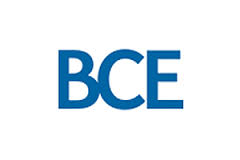
MONTREAL – Despite an uptick in revenue, BCE saw its fourth quarter profits sag under the weight of an asset writedown and other expenses, the company said Thursday.
For the quarter ended December 31, the company saw operating revenue increase 3.0% to $6.22 billion, driven by a 1.5% increase in service revenue that reflected year-over-year growth for all Bell operating segments. Product revenue increased 11.3% as a result of a higher sales mix of premium smartphones and stronger data equipment sales to large business customers.
Net earnings fell 8.0% to $642 million, while net earnings attributable to common shareholders dropped 7.6% to $606 million. Despite higher adjusted EBITDA, net earnings were down due to increased depreciation and amortization expense, greater interest expense, higher severance, acquisition and other costs, and higher other expense attributable to $190 million in non-cash asset impairment charges at Bell Media, mainly related to its French-language TV properties.
Excluding severance, acquisition and other costs, net losses on investments, net mark-to-market changes on derivatives used to economically hedge equity settled share-based compensation plans, early debt redemption costs and impairment charges, adjusted net earnings were up 7.9% to $794 million.
BCE’s adjusted EBITDA grew 2.8% in Q4 to $2.40 billion, driven by year-over-year increases of 5.1% at Bell Wireless, 1.3% at Bell Wireline and 2.9% at Bell Media. BCE’s consolidated adjusted EBITDA margin decreased slightly to 38.5% from 38.6% in Q4 2017, the result of strong year-over-year growth in lower-margin wireline and wireless product revenue.
The Montreal-based telco and media company added 143,114 net new wireless subscribers (121,780 postpaid and 21,334 prepaid), 29,627 net new high-speed Internet customers and 36,473 net new IPTV customers, and had a net loss of 27,220 satellite TV customers and 61,442 residential NAS lines.
At the beginning of Q4 2018, the company’s postpaid wireless subscriber base was adjusted to reflect the transfer of 20,000 customers to Xplornet Communications Inc., the result of a consent agreement with the Competition Bureau to divest a portion of the postpaid wireless subscribers gained with the acquisition of Manitoba Telecom Services Inc. (MTS).
At the end of 2018, BCE said that customer connections across wireless, Internet, TV and residential NAS totalled 19,387,682 up 1.9% from last year. The total included 9,610,482 wireless customers, up 4.8% (including 8,830,216 postpaid customers, an increase of 4.9%); 3,933,931 high-speed Internet subscribers, up 3.8%; 2,853,081 TV subscribers, up 0.7% (including 1,675,706 IPTV customers, an increase of 8.1%); and 2,990,188 residential NAS lines, down 7.5%.
George Cope, president and CEO of BCE and Bell Canada, said that Bell’s all-fibre network buildout is now 50% complete and available to 4.6 million homes and business locations, and that its LTE Advanced (LTE-A) service now covers 91% of the national population.
“We are also deploying full broadband Internet service into smaller towns and rural locations with leading-edge Wireless to the Home (WTTH) technology that is fully upgradeable to 5G wireless service in future”, he said in a statement. “Today, Bell announces that we are expanding our Wireless Home Internet rollout plan in rural Canada by a full 50%, from 800,000 to 1.2 million households, a major infrastructure expansion due directly to the federal government’s Accelerated Investment Incentive program.”
Cope also said that stronger TV advertising demand and an increase in Crave subscribers helped Bell Media to post “our best quarterly media financial performance in 2 years.”
During the company’s fourth quarter conference call, Cope reminded analysts that Crave reached the 2.3 million subscriber mark now because it counts both “linear and direct customers on that service”, which of course includes the former TMN-branded pay-TV channel customers.
When asked later if Crave is showing a profit, Cope added: “Crave is profitable because we’ve obviously… combined it with our linear business and OTT business… when you’re on a TV subscription or over the top provides us a profitable business model going forward.
“Our goal here is putting some (content) that traditionally was only available through linear and not over the top, will also help us improve our mix of over the top subscribers.”
For 2019, BCE said that it is projecting revenue growth in the range of 1% – 3%, and adjusted EBITDA growth of 5% – 7%.
The full details of BCE’s Q4 2018 financial results are available here.


